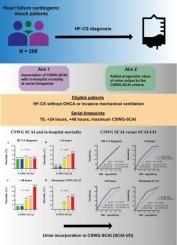心源性休克工作组修改SCAI标准对早期心力衰竭相关心源性休克的预测价值
IF 2.5
Q2 CARDIAC & CARDIOVASCULAR SYSTEMS
引用次数: 0
摘要
心源性休克工作组修改的心血管血管造影与干预学会(CSWG-SCAI)已在心力衰竭(HF)相关的心源性休克(CS)患者中得到验证。其对早期HF-CS患者的预后价值研究甚少。方法分析208例HF-CS患者诊断时CSWG-SCAI分期、24、48 h CSWG-SCAI最高分期与住院死亡率的关系。此外,还评估了尿量(UO)对CSWG-SCAI的附加值。结果HF-CS诊断以A期和B期为主(33%和36%),C期以24 h(51%)、48 h(44%)和最大CSWG-SCAI(37%)为主。共有87例(42%)患者在住院期间死亡。在诊断HF-CS时,较低分期(A/B)与较严重分期(C/D/E)的预后价值相似(p = 0.994)。CSWG-SCAI与24小时(p = 0.005)、48小时(p = 0.005)和最大CSWG SCAI时的住院死亡率相关(p < 0.001)。24小时后分期恶化与死亡率相关(恶化vs.改善:p <; 0.001)。与CSWG-SCAI相比,SCAI- uo在48 h时表现出适度的加性预测值(AUC 0.67 vs AUC 0.70, p = 0.015), SCAI最大(AUC 0.66 vs AUC 0.69, p = 0.032)。结论在诊断HF-CS时,CSWG-SCAI分级不能预测院内死亡率,提示其可能不能充分反映早期HF-CS的严重程度。CSWG-SCAI分级与24小时和48小时以及最大CSWG-SCAI时的住院死亡率相关。将UO纳入CSWG-SCAI标准,最低限度地改善了风险分层。本文章由计算机程序翻译,如有差异,请以英文原文为准。

Predictive value of the cardiogenic shock working group-modified SCAI criteria in early-stage heart failure-related cardiogenic shock
Background
The Cardiogenic Shock Working Group-modified Society for Cardiovascular Angiography and Interventions (CSWG-SCAI) has been validated in patients with cardiogenic shock (CS) related to heart failure (HF). Its prognostic value in patients with early-stage HF-CS has been scarcely investigated.
Methods
In 208 patients with HF-CS, the relationship between the CSWG-SCAI stage at diagnosis, at 24 and 48 h, the maximum CSWG-SCAI stage, and in-hospital mortality were assessed. In addition, the added value of urine output (UO) to the CSWG-SCAI was evaluated.
Results
At HF-CS diagnosis, stages A and B were most prevalent (33 % and 36 %), while stage C dominated at 24 h (51 %), 48 h (44 %) and maximum CSWG-SCAI (37 %). In total, 87 (42 %) patients died during hospitalization. At HF-CS diagnosis, lower stages (A/B) showed similar prognostic value compared to more severe stages (C/D/E) (p = 0.994). The CSWG-SCAI was associated with in-hospital mortality at 24 h (p = 0.005), 48 h (p = 0.005) and at maximum CSWG SCAI (p < 0.001). Stage deterioration after 24 h was associated with mortality (deteriorated vs. improved: p < 0.001). SCAI-UO showed modest additive predictive value at 48 h (AUC 0.67 vs. AUC 0.70; p = 0.015) and maximum SCAI compared to CSWG-SCAI (AUC 0.66 vs. AUC 0.69; p = 0.032).
Conclusions
At the time of HF-CS diagnosis, the CSWG-SCAI classification failed to predict in-hospital mortality, suggesting that it may not adequately capture the severity of early-stage HF-CS. The CSWG-SCAI classification was associated with in-hospital mortality at 24 and 48 h and at maximum CSWG-SCAI. Incorporating UO into the CSWG-SCAI criteria minimally improved risk stratification.
求助全文
通过发布文献求助,成功后即可免费获取论文全文。
去求助
来源期刊

IJC Heart and Vasculature
Medicine-Cardiology and Cardiovascular Medicine
CiteScore
4.90
自引率
10.30%
发文量
216
审稿时长
56 days
期刊介绍:
IJC Heart & Vasculature is an online-only, open-access journal dedicated to publishing original articles and reviews (also Editorials and Letters to the Editor) which report on structural and functional cardiovascular pathology, with an emphasis on imaging and disease pathophysiology. Articles must be authentic, educational, clinically relevant, and original in their content and scientific approach. IJC Heart & Vasculature requires the highest standards of scientific integrity in order to promote reliable, reproducible and verifiable research findings. All authors are advised to consult the Principles of Ethical Publishing in the International Journal of Cardiology before submitting a manuscript. Submission of a manuscript to this journal gives the publisher the right to publish that paper if it is accepted. Manuscripts may be edited to improve clarity and expression.
 求助内容:
求助内容: 应助结果提醒方式:
应助结果提醒方式:


